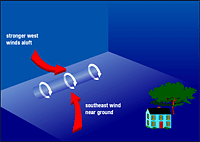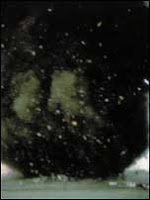A Operational Definition
The National Oceanic and Atmospheric Administration (NOAA, 1992) defines the tornado “as a violently rotating column of air extending from a thunderstorm to the ground.” It is characterized with wind speeds averaging 30 to 70 mphs, occasionally greater than 250 mph with trajectories 50 miles and beyond in distance (NOAA, 1992). According to the National Climatic Data Center (NCDC, 2008), these phenomena are not confined to a specific region and have occurred within several geographic locations with the exception of Antarctica.
Research has evidenced that:
the middle latitudes between 30° and 50° North or South, provide the most favorable environment for tornadogenesis. This is the region where cold, polar air meets against warmer, subtropical air often generating convective precipitation along the collision boundaries. In addition, air in the mid-latitudes often flows at different speeds and directions at different levels of the troposphere, facilitating the development of rotation within a storm cell…as a result of the large number of convective storms and the favorable environment, the odds are increased that some of these storms will produce tornadoes. (NCDC, 2008)
This convergence of cold and warm fronts induces the condensation needed to create funnel shaped cumulonimbus clouds typical of severe convection thunderstorms known as super cells. The convective storms or super cells then provide the precipitation and the warmth needed in the development and the mobilization of a tornado. Figure 1. illustrates the development of a tornado.
Tornadoes vary in their genesis. Tornadoes generated by thunderstorms may occur over land or water. For instance in the United States, land born tornadoes occur along the anterior range of the “Rocky Mountains, the Plains, and the Western States” (NOAA, 1992). Such tornadic events may not appear visible, but then transition to a grey, brown or red color when dust and debris are enveloped. Tornadoes that develop over water are termed waterspouts, tending to be weaker and ubiquitous to the Gulf Coast (NOAA, 1992). Waterspouts can migrate on to continents to become inland tornadoes anteceded by thunderstorms and accompanied with flash floods, lightening, and hail (NCDC, 2008).
Research has evidenced that:
the middle latitudes between 30° and 50° North or South, provide the most favorable environment for tornadogenesis. This is the region where cold, polar air meets against warmer, subtropical air often generating convective precipitation along the collision boundaries. In addition, air in the mid-latitudes often flows at different speeds and directions at different levels of the troposphere, facilitating the development of rotation within a storm cell…as a result of the large number of convective storms and the favorable environment, the odds are increased that some of these storms will produce tornadoes. (NCDC, 2008)
This convergence of cold and warm fronts induces the condensation needed to create funnel shaped cumulonimbus clouds typical of severe convection thunderstorms known as super cells. The convective storms or super cells then provide the precipitation and the warmth needed in the development and the mobilization of a tornado. Figure 1. illustrates the development of a tornado.
Tornadoes vary in their genesis. Tornadoes generated by thunderstorms may occur over land or water. For instance in the United States, land born tornadoes occur along the anterior range of the “Rocky Mountains, the Plains, and the Western States” (NOAA, 1992). Such tornadic events may not appear visible, but then transition to a grey, brown or red color when dust and debris are enveloped. Tornadoes that develop over water are termed waterspouts, tending to be weaker and ubiquitous to the Gulf Coast (NOAA, 1992). Waterspouts can migrate on to continents to become inland tornadoes anteceded by thunderstorms and accompanied with flash floods, lightening, and hail (NCDC, 2008).

1) Before thunderstorms develop, a change in wind direction and an increase in wind speed with increasing height creates an invisible, horizontal spinning effect in the lower atmosphere.

2)Rising air within the thunderstorm updraft tilts the rotating air from horizontal to vertical.

3) An area of rotation, 2-6 miles wide, now extends through much of the storm. Most strong and violent tornadoes form within this area of strong rotation.

4) Woodward OK (Ron Przybylinski)
A lower cloud base in the center of the photograph identifies an area of rotation known as a rotating wall cloud. This area is often nearly rain-free. Note rain in the background.

5) Woodward OK (Ron Przybylinski)
Moments later a strong tornado develops in this area. Softball-size hail and damaging "straight-line" winds also occurred with this storm.
Source:The Development of a Tornado (NOAA, 1992)
B Intensity and Frequency
Tornadoes are perennial but predominate during March, April and May as well as during the summer in southern and northern states respectively in the US. During the afternoon, specifically from 3-9pm there is increased probability for convective thunderstorms, which increases the likelihood for tornadic activity. The southern states of the U.S. such as “central Texas, northward to northern Iowa, and from central Kansas and Nebraska east to western Ohio” dubbed Tornado Alley, and Gulf states called Dixie Alley, for example Louisiana and Mississippi in the U.S. have characteristically high occurrences of afternoon convective storms (NCDC, 2008). The U.S has the highest occurrence of tornadoes bearing 77% of global tornadic activity as a result of afternoon convective conditions prime for the development of severe, large-scale thunderstorms (NCDC, 2008). Tornado intensity and speed are measured using the enhanced Fujita Scale form EF0 to EF5; the former being the lowest and slowest whilst the latter is the strongest and fastest ranking. Figure 2 provides insight into the attributes and strengths of tornadoes (NOAA, 1992).

Weak Tornadoes
69% of all tornadoes
Less than 5% of tornado deaths
Lifetime 1-10+ minutes
Winds less than 110 mph

Strong Tornadoes 29% of all tornadoes
Nearly 30% of all tornado deaths May last 20 minutes or longer
Winds 110-205 mph

Violent Tornadoes
Only 2% of all tornadoes 70% of all tornado deaths
Lifetime can exceed 1 hour
(NOAA, 1992)
C Relationship to climate change
There seems to not be a tenable correlation between tornadoes and climate change. Research posits that the influence of El Nino may increase the frequency and magnitude of tornadic activity, however empirical support has been inadequate in buttressing these suppositions. Instead, some critics declare attempts to link tornadoes to climate change as scare tactics when these phenomena result from mother nature. Naturally, when warm and cold air masses converge during jet stream or front collisions, warm air is trapped. When large masses of warm air are retained, the eventual release of the imprisoned air lends to the maturity of convective storms which potentiate the occurrence of tornadoes (“Tornadoes,” 2003).
Supporters of the relationship between tornadoes, global warming and climate change suggest that elevated levels of carbon dioxide not only cause higher temperatures but also cause the entrapment of warm air masses in the atmosphere. In the El Nino effect, higher temperatures mean warmer oceanic currents warming the atmosphere for protracted time periods, thus facilitating conditions for thunderstorm and tornado development. The belief is that global warming exacerbates natural phenomenon to result in the increasing frequency and magnitude of tornadic activity. However, although there have been increased reports of tornadoes, the NCDC (2008) declares that “there has been little trend in the frequency of the strongest tornadoes over the past 55 years.” In other words although theories persist, there currently is inferior validation for the increased magnitude and frequency of tornadic disasters as a result of climatic change during the past years till present.
Supporters of the relationship between tornadoes, global warming and climate change suggest that elevated levels of carbon dioxide not only cause higher temperatures but also cause the entrapment of warm air masses in the atmosphere. In the El Nino effect, higher temperatures mean warmer oceanic currents warming the atmosphere for protracted time periods, thus facilitating conditions for thunderstorm and tornado development. The belief is that global warming exacerbates natural phenomenon to result in the increasing frequency and magnitude of tornadic activity. However, although there have been increased reports of tornadoes, the NCDC (2008) declares that “there has been little trend in the frequency of the strongest tornadoes over the past 55 years.” In other words although theories persist, there currently is inferior validation for the increased magnitude and frequency of tornadic disasters as a result of climatic change during the past years till present.
References
National Climatic Data Center. (2008). U.S. Tornado Climatology. Retrieved July 22, 2008 from http://lwf.ncdc.noaa.gov/oa/climate/severeweather/tornadoes.html
National Oceanic and Atmospheric Administration. (1992). Tornadoes…world’s most violent storm. Retrieved July 21, 2008, from http://www.nssl.noaa.gov/edu/safety/tornadoguide.html
(2003). Record number of tornadoes tied to global warming. Retrieved July 21, 2008, from http://www.unknowncountry.com/news/?id=2701
0 comentarios:
Post a Comment